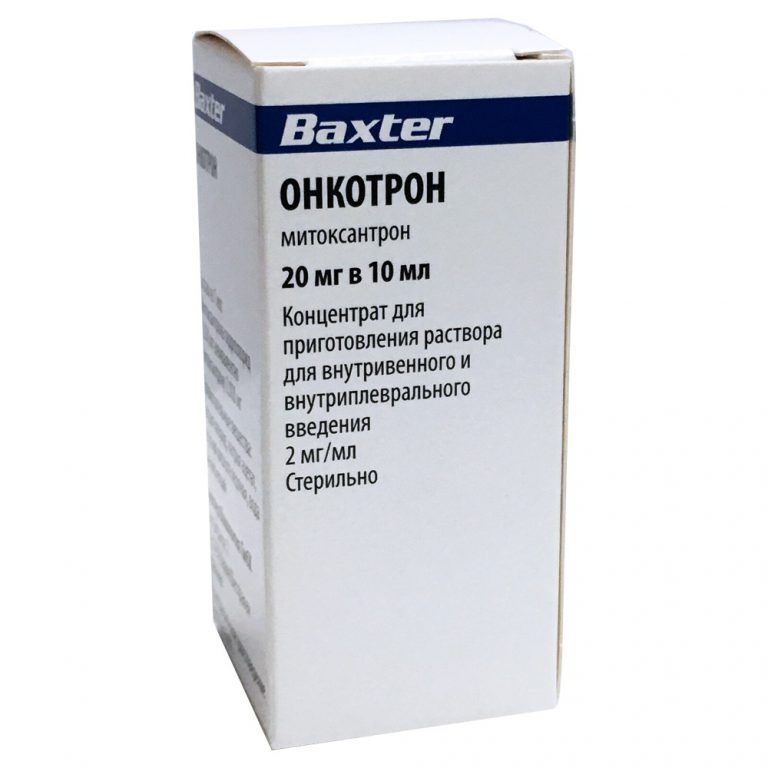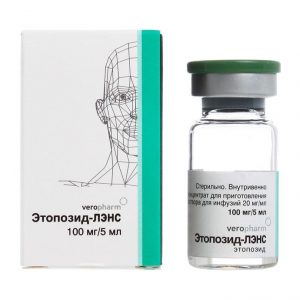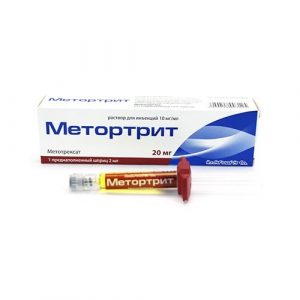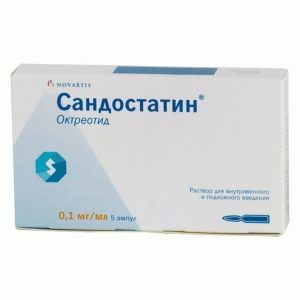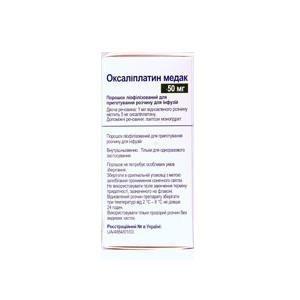Description
Latin name
ONCOTRONE
Release form
Concentrate for the preparation of a solution for iv and intrapleural administration.
Packaging
In a bottle of 10 ml of concentrate. In a cardboard box 1 bottle.
Pharmacological action
Pharmacodynamics
Oncotron is a cytotoxic drug, a synthetic derivative of anthracedion. The mechanism of the antitumor action has not been fully elucidated, but preliminary data indicate that the drug, integrating itself between the bases of the DNA molecule, blocks the processes of replication and transcription. In addition, mitoxantror inhibits topoisomerase II, has a nonspecific effect on the cell cycle.
Pharmacokinetics
After iv administration, mitoxantrone rapidly penetrates and is distributed in tissues, from where its gradual release then occurs. It is found in high concentrations in the liver, lungs and in decreasing order: in the bone marrow, heart, thyroid gland, spleen, pancreas, adrenal glands and kidneys. It does not penetrate the BBB.
Plasma Protein Binding – 90%. Metabolized in the liver. Within 5 days, 13.6-24.8% and from urine from 5.2% to 7.9% of the drug are excreted from the body with bile. Terminal T1 / 2 reaches 9 days.
In patients with impaired liver function, a decrease in the elimination rate of the drug was noted.
Indications
Acute non-lymphoblastic leukemia in adults
breast cancer
malignant non-Hodgkin lymphoma
primary hepatic cell cancer
ovarian cancer
hormone-resistant prostate cancer with pain
Contraindications
Neutrophil count less than 1500 / l (except for treatment of non-lymphoblastic leukemia)
lactation period
pregnancy
hypersensitivity to mitoxantrone or any other components of the drug.
With caution: Oncotron is used in patients with heart disease, with previous mediastinal irradiation, with inhibition of hematopoiesis, with severe impaired liver or kidney function, with bronchial asthma, with acute infectious viral diseases (including chicken pox, herpes zoster), fungal or bacterial nature (risk of serious complications and generalization of the process), with diseases in which increased risk of developing hyperuricemia (gout or urate nephrolithiasis) and in patients who have previously received anthracyclines.
Use during pregnancy and lactation
Contraindicated in pregnancy and lactation.
Composition of
1 ml of concentrate contains:
Active ingredients:
mitoxantrone hydrochloride 2.328 mg, which corresponds to a 2 mg mitoxantrone content.
Excipients:
sodium chloride,
sodium acetate,
glacial acetic acid,
d / i water.
Dosage and administration of
Mitoxantrone is a part of many chemotherapeutic treatment regimens, and therefore, when choosing a route of administration, regimen and doses in each individual case, one should be guided by the data of the specialized literature.
The drug is administered intravenously slowly for at least 5 minutes or iv drip for 15-30 minutes. It is preferable to introduce Oncotron into the tube of the infusion system of slownon against the background of rapid infusion with 0.9% sodium chloride solution or 5% glucose solution.
Intrathecal, intra-arterial, in / m, s / c administration of the drug is prohibited
The maximum total dose of Oncotron is 200 mg / m2 of body surface.
For breast cancer, non-Hodgkin s lymphoma, liver cancer and ovarian cancer, Oncotron monotherapy is used at a dose of 14 mg / m2 once every 3 weeks. In patients who have previously received chemotherapy, as well as when combined with other antitumor agents, the dose of the drug is reduced to 10-12 mg / m2. With repeated courses, doses of Oncotron are selected taking into account the severity and duration of inhibition of bone marrow hematopoiesis.
In the case of a decrease in the number of neutrophils at previous courses of <1,500 and / or platelets of 50,000 cells / μl of blood, the dose of Oncotron decreases by 2 mg / m2 with a decrease in the number of neutrophils of <1000 and / or platelets of <25,000 cells / μl, subsequent doses of Oncotron are at 4 mg / m2. In the treatment of acute non-lymphoblastic leukemia in adults, Oncotron is prescribed at a dose of 10-12 mg / m2 daily for 5 days to a total dose of 50-60 mg / m2 for the induction of remission. It is possible to use high doses of Oncotron of 14 mg / m2 or more daily for 3 days. For the treatment of hormone-resistant prostate cancer, Oncotron is prescribed at a dose of 12-14 mg / m2 once every 21 days in combination with a daily intake of low doses of glucocorticosteroids (prednisone) 10 mg / day or hydrocortisone 40 mg / day). For intrapleural installation, for metastases in the pleura (for breast cancer and non-Hodgkin lymphomas), the recommended single dose is 20-30 mg. For intrapleural installation, Oncotron is diluted in 50 ml of 0.9% sodium chloride solution. Before starting therapy, pleural exudate is evacuated, as far as possible. Oncotron diluted in 50 ml of 0.9% sodium chloride solution is warmed to body temperature and injected slowly over 5-10 minutes, without the use of force. The period of delay of the first dose of Oncotron in the pleural cavity is 48 hours. During this period, patients should move to ensure optimal intrapleural distribution of the drug. After the specified time (48 hours), a repeated drainage of the pleural cavity is performed. If the amount of effusion is less than 200 ml, then the 1st cycle of treatment is terminated. If the amount of effusion exceeds 200 ml, a second installation of 30 mg of Oncotron is prescribed. Before re-installing the drug, it is necessary to control hematological parameters. The 2nd dose of Oncotron may remain in the pleural cavity. The maximum dose for the 1st treatment cycle is 60 mg. If the number of neutrophils and platelets is within normal limits, the intrapleural installation can be repeated after 4 weeks. For 4 weeks before and 4 weeks after intrapleural administration of Oncotron, systemic therapy with cytostatic agents should be avoided. Side effects From the hematopoietic system: leukopenia (usually 6-15 days, recovery on 21 days), neutropenia. thrombocytopenia, erythrocytopenia rarely – anemia. From the digestive system: nausea, vomiting, anorexia, decreased appetite, diarrhea, abdominal pain, constipation, gastrointestinal bleeding, stomatitis rarely – increased activity of hepatic transaminases, impaired liver function. From the cardiovascular system: ECG changes, tachycardia,Ca of the left ventricle, congestive heart failure. Toxic myocardial damage, in particular congestive heart failure, can develop both during treatment with mitoxantrone and months and years after the end of therapy. The risk of a cardiotoxic effect increases when a total dose of 140 mg / m2 is reached. From the respiratory system: cases of interstitial pneumonitis have been described. Allergic reactions: itchy skin. rash, urticaria, shortness of breath, decreased blood pressure, anaphylactic reactions (including anaphylactic shock). Local reactions: phlebitis, with estratization – erythema, edema, pain, burning, necrosis of surrounding tissues. Cases of intense blue staining of veins into which the drug and surrounding tissues were injected are described. Other: alopecia, fatigue, general weakness, fever, non-specific neurological symptoms, back pain, headache, menstrual irregularities, amenorrhea rarely – blue staining of the skin and nails is very rare – dystrophy of the nails and reversible blue staining of the sclera, secondary infections, hyperuricemia, hypercreatininemia. Drug Interaction Pharmaceutical Interaction Do not mix the drug with other agents when injected (precipitate may precipitate). Pharmacodynamic interaction Oncotron potentiates the action of many cytotoxic agents, such as cytarabine, cisplatin, cyclophosphamide, 5-fluorouracil, methotrexate, vincristine, dacarbazine. When used with Oncotron with other antitumor agents or irradiation of the mediastinum, it may increase its cardio and myelotoxicity. Simultaneous administration of drugs, blocking tubular secretion (including uricosuric anti-gout agents – sulfinpyrazone) may increase the risk of nephropathy. Pharmacokinetic interaction No hazardous interactions with other medicinal products have been observed. Overdose Symptoms: increased, first of all, myelotoxicity and the above side effects. Treatment: dialysis is not effective. In case of overdose, careful monitoring of the patient should be established and symptomatic therapy should be performed if necessary. The specific antidote for mitoxantrone is unknown. Storage conditions Keep out of the reach of children at a temperature not exceeding 25 ° C. Do not freeze. Expiration 3 years. Deystvuyuschee substances Mytoksantron Dosage form Dosage form infusion solution
